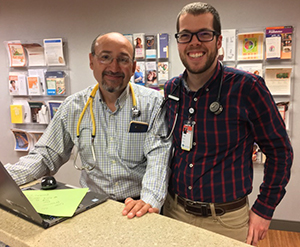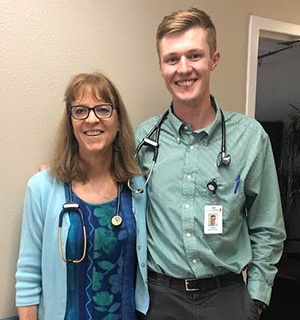
Contact Us
Institutional Communications
Bureau of Mines Building, Room 137
Laramie, WY 82071
Phone: (307) 766-2929
Email: cbaldwin@uwyo.edu
UW Medical Education Program Prepares Students for Practice in Rural, Underserved Communities
Published August 13, 2019

At left, Dr. Hermilo Gonzalez works with Caleb Brackett, a Wyoming WWAMI medical student,
on-site in Buffalo. During his time in the Rural/Underserved Opportunities Program,
Brackett saw numerous patients and provided medical treatments including suturing
wounds, applying splints and giving vaccinations. (WWAMI Photo)
With a total of 544 physicians serving a population of about 580,000 people spread across 97,818 square miles, Wyoming ranks 44th in the nation when it comes to having a sufficient physician workforce.
While there’s a clear need for more physicians to serve the rural and underserved communities throughout the state, the challenge is not only how to prepare medical students for practice in those communities -- but also to help them remain in practice and better serve their communities.
The WWAMI Medical Education Program at the University of Wyoming does that through the Rural/Underserved Opportunities Program (RUOP). The four-week elective immersion experience in community medicine -- for students between their first and second year of medical school -- provides students early exposure to primary care medicine in a rural or urban underserved setting; promotes a positive attitude toward practicing medicine in rural communities; and gives students an opportunity to learn how community health care systems function.
WWAMI is a five-state education consortium for Washington, Wyoming, Alaska, Montana and Idaho -- all of which share similar geographical and socio-economic characteristics. Wyoming residents attending medical school as part of the WWAMI program receive their degrees from the University of Washington School of Medicine (UWSOM). Over the past 25 years, UWSOM has been ranked as one of the top three primary care medical schools in the country.
“It is an established fact that one of the most important predictors of physicians choosing to practice in rural locations is whether or not the physician was exposed to rural care in medical school,” says WWAMI Director Timothy Robinson. “UWSOM offers over 200 clinical training sites, a significant portion of which are rural, throughout the five-state WWAMI region.”
During their RUOP experience, medical students each work closely with a preceptor -- a physician with an established practice. Eleven medical students were placed throughout Wyoming as part of this summer’s RUOP.
Caleb Brackett, a Wyoming WWAMI student from Big Piney, worked alongside Dr. Hermilo Gonzalez in Buffalo.
“RUOP has been an incredible experience filled with hands-on application of clinical knowledge,” Brackett says. Noting the training he received, he says, “I've been able to suture, splint, vaccinate, screen and interview numerous patients.”
While they’re involved in the RUOP, teaching continues as a vital part of helping medical students advance their education. “The program allows for reinforcement of first-year lecture material and stresses the importance of a good patient history and physical exam,” Brackett says.
“My doctor has been an incredibly good teacher, and I've been able to see everything from a bullet wound to C-sections and Tetralogy of Fallot (congenital heart condition) to Paget's disease (bone disease),” he says. “It's been an invaluable experience.”

At left, Dr. Jackie Nelson serves as a preceptor for Wyoming WWAMI medical student
Conner Morton on the Wind River Indian Reservation. Morton’s training in the Rural/Underserved
Opportunities Program helped him better understand patients’ family and community
structure. (WWAMI Photo)
Understanding the needs of a community is critical for a physician practicing in rural and underserved communities. Conner Morton, a Wyoming WWAMI student from Casper, says he learned a great deal about specific community needs while serving in RUOP on the Wind River Indian Reservation.
“At my RUOP site, I had the opportunity to work at the Indian Health Service facilities on the Wind River reservation. Along with seeing Northern Arapaho and Eastern Shoshone patients in the clinic, I was able to see the strong family bonds and spirituality within the community,” Morton says.
He continues, “The Northern Arapaho Sundance grounds, scattered with teepees, tents and campers, embodied the resiliency and preservation of a culture with a tumultuous history, while Eastern Shoshone Tribal Health showed me how the Shoshone people recognize their health disparities and are taking actions to address them. Overall, it was an extremely positive experience.”
Noting that RUOP provides students the training needed to become a physician able to serve the medical needs of rural Wyoming communities, Wyoming WWAMI student Ola Zarzycka explains, “My RUOP experience in Sundance has been the best clinical experience I have had thus far in my medical education. I have enjoyed being in a rural community because I got the chance to know the community members and the patients.”
Zarzycka adds, “My preceptor, Dr. Waddell, has been exceptionally involved in my clinical education. He pushes me to think harder and tests my knowledge. I am looking forward to coming back to Wyoming to practice medicine.”
For Sandra Ritchie, a medical student based in Seattle, RUOP was an opportunity to explore medicine in Laramie, a community much different from that to which she is accustomed.
“Working with Dr. Bjore, a geriatrician at Ivinson Memorial Hospital, and her team was wonderful. It felt like being part of a family,” says Ritchie. “Dr. Bjore is the greatest. Her professionalism, her tremendous knowledge and her patience with and compassion for her patients all impressed me. She’s been an excellent role model.”
“It also has been priceless to learn about the differences between the workings of a health care system in a smaller city compared to Seattle,” Ritchie says. “Understanding available resources, both local and distant, is even more important in rural settings. The research portion of RUOP helped a lot with this. It encouraged plugging into the community and learning more about local services.
“I also cherished the strong sense of community, both within the clinic setting and out and about in Laramie. Participating in local events was a highlight of my experience. Laramie is a wonderful place. I can’t wait to return,” says Ritchie.
Marivern Easton, WWAMI assistant director and RUOP coordinator, places 10 to 15 medical students each summer with physicians throughout Wyoming.
“RUOP is a very popular program. Students have overwhelmingly positive experiences living and learning in communities across the state,” she says. “We are grateful for the physician preceptors who volunteer their time to work with our medical students. Early exposure to our rural and frontier communities is important both for the student and for the community.”
Medical students each are required to complete a community health plan as part of the RUOP research component. Those plans will be presented in a poster session at the WWAMI Research Symposium, hosted by Ivinson Memorial Hospital Nov. 7. Past poster presentations can be found on the Wyoming WWAMI RUOP site.
Current participating students and physician preceptors, listed by their RUOP communities, are:
Buffalo -- Caleb Brackett, of Big Piney; Dr. Hermilo Gonzalez.
Cody -- Sean McCue, of Cody; Dr. Adam Peters.
Douglas -- Adam Blaine, of Gillette; Dr. Casey Starks.
Evanston -- Kiarra Levesque, of Seattle; Dr. Spencer Weston.
Fort Washakie -- Conner Morton, of Casper; Dr. Jackie Nelson.
Gillette -- Marina Tkachenko, of Seattle; Dr. Erica Rinker.
Laramie -- Sandra Ritchie, of Seattle; Dr. Emma Bjore.
Powell -- Amanda Golden, of Cody; Dr. Nicole Comer.
Sheridan -- Daulton Grube, of Rock Springs; Dr. Ian Hunter.
Sundance -- Ola Zarzycka, of Cheyenne; Dr. Heith Waddell.
Thermopolis -- Marcus Couldridge, of Casper; Dr. Travis Bomengen.
To learn more about WWAMI Medical Education, visit www.uwyo.edu/wwami.
Contact Us
Institutional Communications
Bureau of Mines Building, Room 137
Laramie, WY 82071
Phone: (307) 766-2929
Email: cbaldwin@uwyo.edu
